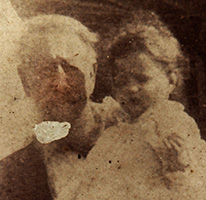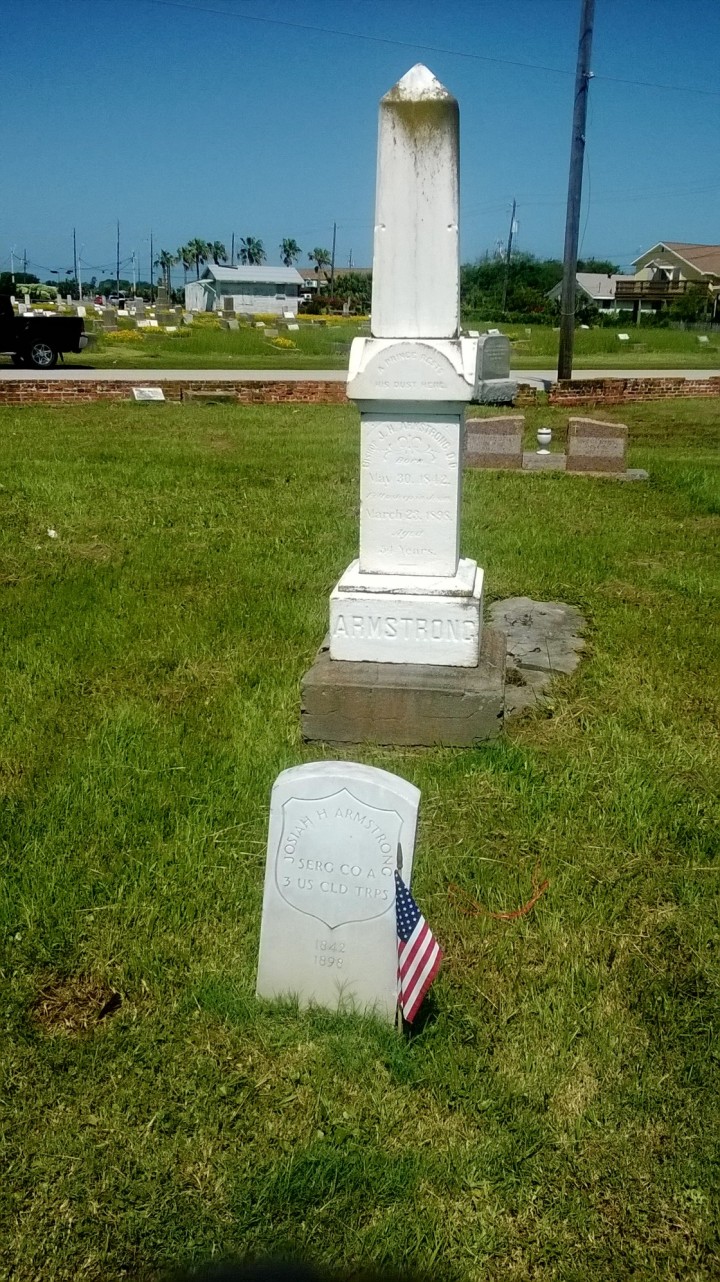Three Veterans
Note: This is the first of three posts that I republish every Memorial Day weekend. Last week I was traveling, and so was unable to post them over several days as I usually do.
_______
This Memorial Day weekend, I’d like to highlight three Civil War veterans interred here in Galveston. I don’t have a familial or personal connection to any of them, but I think of them as neighbors of mine, of a sort.



Charles DeWitt Anderson (1827-1901) served as a Colonel in the Confederate army, and in the summer of 1864 was charged with the defense of Fort Gaines, on the eastern side of the entrance to Mobile Bay. After Admiral Farragut forced the entrance to Mobile Bay on August 4, Anderson found himself entirely cut off, besieged and under artillery fire from the land side of Dauphin Island and unable to have any effect on the Federal fleet, which had moved farther up Mobile Bay, out of range of Fort Gaines’ guns. Faced with demoralized Confederate troops inside the fort, Anderson surrendered on August 8. Given a choice of surrendering to the U.S. Army or Navy, Anderson turned over his sword to Farragut. One of Farragut’s last acts before he died in 1870 was to request that Anderson’s sword be returned to him. It came back to Anderson with the inscription, “Returned to Colonel C. D. Anderson by Admiral Farragut for his Gallant Defence of Fort Gaines, April 8, 1864.”
What fewer people know about Anderson is that he and his younger brother arrived in Texas as orphans, their parents having died on the ship en route to the Republic of Texas in 1839. They were adopted right there on the wharf by an Episcopal minster. In 1846, Anderson was the first cadet admitted to West Point from the newly-established State of Texas; his application letter was endorsed by U.S. Senator Sam Houston. Although Anderson did not graduate from the Point, he eventually received a direct commission into the Fourth U.S. Artillery in 1856, and served until resigning his commission in 1861. Anderson served longer as a U.S. Army officer than as a Confederate one; you can view a detail of an 1859 map drawn by Anderson of the area around Fort Randall, Dakota Territory, here.
In his postwar years he worked as an engineer on a variety of public works projects, and at the time of his death was serving as the keeper of the Fort Point Lighthouse here. William Thiesen, the Atlantic Area Historian for the U.S. Coast Guard, recently wrote about Anderson’s experience at Fort Point during the 1900 Storm, the deadliest natural disaster in U.S. history. Recall that, at the time, Anderson was in his seventies:
True to his mission, Anderson kept the light burning during the storm even though most ships by then were either adrift, out of control or washing ashore at points along the Texas coast. However, late that evening, floodwaters surged and carried off equipment on the lighthouse’s lower deck, including the lifeboat and storage tanks for fresh water and kerosene fuel. With seawater rising into the keeper’s quarters it seemed as if Fort Point Lighthouse was adrift on a stormy sea. With the wind speeds nearing 200 miles per hour, the lighthouse’s heavy slate roof began to peel away. Eventually, some of the flying stone tiles shattered the lantern room windows and the inrushing wind snuffed out the light for good.
Anderson had tried his best to maintain the light, but the flying glass had lacerated his face and driven him below. By late that evening, the quarters’ first floor had flooded, the wind had permanently extinguished the light, Keeper Anderson suffered from facial wounds and the storm surge had trapped the elderly couple on the second floor. With all hope lost, Anderson and wife Lucy made their way to the second floor parlor room, sat down and waited in silence for the floodwaters to take them away.
But the end never came. On Sunday morning, the Andersons emerged arm-in-arm onto the lighthouse gallery to see the human toll of the hurricane. The scene they witnessed beggars description. In a silent watery funeral procession, the ebbing tide carried away countless bodies from Galveston Bay to the Gulf of Mexico. Anderson likely saw as much carnage, if not more, than at any time during his Civil War career. But, unlike the war, the storm did not favor one victim over another; instead, it took the lives of women and children as well as men.
____



George Frank Robie (1844-91) was a Sergeant in Company D of the Seventh New Hampshire Volunteer Infantry, who won the Medal of Honor “for gallantry on skirmish line” during fighting around Richmond, Virginia in September 1864.
Robie originally enrolled in the Eighth Massachusetts Militia, a three-month unit, the day after the surrender of Fort Sumter in 1861. His service record gives his age at enlistment as 18, but other sources suggest he was a year younger. After being discharged, he enlisted in the Seventh New Hampshire in September 1861 as a Sergeant. He re-enlisted in the regiment in February 1864, and was appointed First Lieutenant in October. Although Robie was recommended for a medal during the war, his Medal of Honor, like many, was not actually awarded until June 1883 by resolution of Congress.
He moved to Galveston after the war, working as a clerk in a railroad office, but suffered from rheumatism that had first afflicted him during his service in Virginia. Robie returned to New England, and in 1884 was awarded a pension for disability. Robie subsequently returned to Galveston, dying here in 1891. To my knowledge, Robie is the only Civil War Medal of Honor winner interred in Galveston County. The Fitts Museum in Candia, New Hampshire, where Robie was born, holds Robie’s sword in its collection.
____



Josiah Haynes Armstrong (1842-98) was a Sergeant in the Third U.S. Colored Infantry. He was born free in Lancaster County, Pennsylvania, enlisted as a Corporal on June 26, 1863 at Philadelphia, and soon thereafter was promoted to Sergeant. The Third U.S.C.I. spent the latter part of the war in the Jacksonville, Florida, area, although Armstrong became ill and was transferred to a military hospital in St. Augustine. Some time later, his company commander, who had heard that Armstrong was convalescent and working at the hospital as a cook, wrote to request that he be sent back to the regiment, as he would “be obliged to make another Sergt in [Armstrong’s] place, which, as he is an excellent non-com officer, I am loathe to do.”
After his discharge, Armstrong remained in Florida, where he became a member of the clergy in the African Methodist Episcopal Church. He also served in the Florida State House of Representatives, representing Columbia County, in 1871, 1872, and 1875. He moved to Galveston in 1880, where he was pastor of Reedy A.M.E. Chapel here. Armstrong also served as Grand Master of the Prince Hall Grand Lodge of Texas, the African American branch of American freemasonry, from 1890 to 1892. He was ordained a Bishop in the A.M.E. Church in 1896, two years before his death at age 56.
_____
Anderson photo courtesy Col. Anderson’s great-grandson, Dale Anderson, and Bruce S. Allardice.






Nice post. I registered with the Selective Service System in Galveston shortly before my 17th birthday (draft lottery #29) and less than a month after moving from Bremerton WA to Friendswood TX for my senior year of high school. The Quaker community there was demolished by that hurricane in 1900 but managed to rebuild and even expand afterward to the point where some of my most influential classmates there in 1971 still had personal recollections of ancestors who had survived that storm. I’ve recently joined the fan club of a Friendswood classmate who escaped from Galveston County, far less completely than I did, by way of a bit part in Urban Cowboy playing herself as a Gillie’s Girl at Mickey Gillie’s Nightclub. Her bit part blossomed into a rock and roll and blues career as a studio musician, song writer and singer in Los Angeles. Her biography starts with Urban Cowboy and the gig it got her as a backup singer for Rita Coolidge on tour in South Africa. But I’ve got a long term membership with Ancestry.com so was able to trace her grandparents’ arrival as immigrants from Armenia shortly after the genocide to East St. Louis and surrounds. Until the advent of the internet I had managed just fine for fifty years without any awareness of my direct family connection to the recent unpleasantness. The discovery of my great great grandfather’s tombstone at Jefferson Barracks National Cemetery uprooted many of my notions of personal identity, particularly as a German (and/or Prussian)-American and particularly with regard to the four years I spent in Friendswood, Houston and Galveston. My Civil War ancestor served as a replacement troop for the last six months of the war and his life with the 27th Wisconsin, commanded by Colonel Konrad Krez, a lawyer, poet and student activist, still highly esteemed in Germany as a poet of the 1848 Revolution. The 27th Wisconsin served in the same brigade of the Army of Arkansas under Major General Frederick Steele as the 43rd Illinois, an originally all German outfit recruited by Gustav Koerner, commanded by Julius Raith and after his death, Koerner’s brother-in-law, Adolph Engelmann, and after Engelmann’s promotion to Brigadier Brevet General, Colonel Adolph Dengler. The 43rd Illinois is still usually referred to as the Koerner Regiment and it occupied Little Rock, Arkansas, along with the 27th Wisconsin and the 33rd Iowa for a year and a half, from the fall of Vicksburg to the beginning of the Siege of Mobile. Colonel Krez memorialized his Civil War service with three poems written in German about three locations where his unit was stationed during the war, Little Rock, New Orleans and Brazos Santiago. I’ve translated those poems. I’m trying to decide if I should ask this former classmate of mine to set these poems to music.